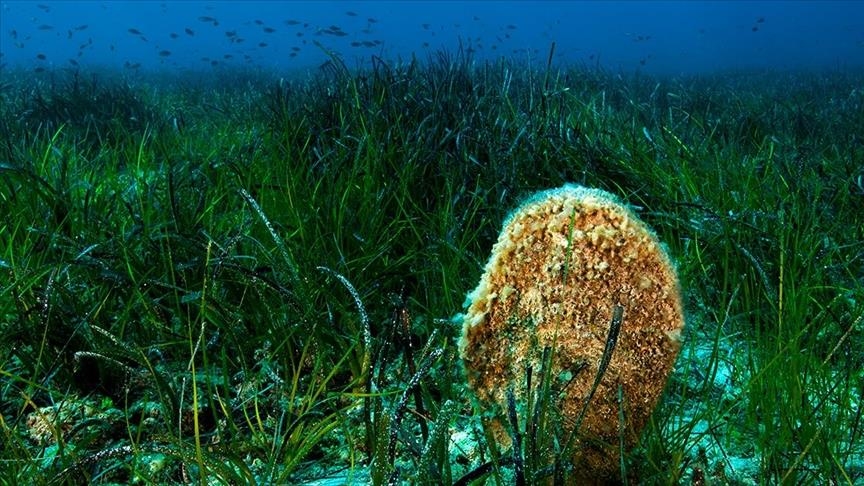Global Courant
ISTANBUL
The President of the Mediterranean Conservation Society (Mediterranean Conservation Society) told Anadolu Agency (AA) that seagrass meadows, which are described as the “lungs of the seas” due to their carbon sequestration feature, are under threat due to increasing temperature, pollution and the mobility of boats.
Zafer Kızılkaya said that these plants, which are sometimes confused with algae, are the only representatives of the flowering plants living on land in the seas, that they bloom and plant seeds.
Kızılkaya said that the seagrass meadows in the Mediterranean are referred to as “Posidonia oceanica” in the literature and that it is an endemic species unique to the Mediterranean Sea and that it is not found in any other sea. the amount of carbon dioxide in seawater.
Kızılkaya also said that an average seagrass can store eight kilograms (17 pounds) of carbon per square meter per year, which is an “incredible number”.
“Research around the world shows that the plant that can store the most carbon in the world is the Mediterranean seagrass. Rainforests can store up to 800 grams (28 ounces) of carbon, while seagrass can store 10 times more carbon than rainforests.
“A facility with such a high carbon storage capability will give us the carbon market tomorrow and the next day. Since we can protect these, Turkey will have a very serious blue carbon inventory.”
Seagrasses, which can live 0 to 40 meters (0-130 feet) above the seafloor and grow up to 50-60 centimeters (1.6-1.96 feet) in a healthy environment, are crucial to the ecosystem. He noted that juvenile fish and invertebrates can hide in seagrass meadows, and squid and squid can lay their eggs there.
More common in shallow seas
Kızılkaya also shared the following figures regarding the population of seagrass meadows in the Mediterranean:
“A total of 56,783 square kilometers (21,924 square miles) of seagrass has been detected off the coasts of 22 countries in the Mediterranean by satellite surveys. Tunisia has the most because the seas around it are so shallow, there are about 6,400 square kilometers (2,471 square miles) of seagrass.
“Italy ranks second with 3,300 square kilometers (1274 square miles). following few. miles).
Explaining that there has been a serious decrease in seagrass meadows in the Mediterranean in the last 100 years, Kızılkaya said, “Many domestic and agricultural pollutions enter the sea near cities and stream mouths and this creates serious pollution. It blocks sunlight. Like a plant, the sea also dies. Read More “The worst thing is that drinking water or bilge water from boats mixes into the sea. Marine traffic and boats’ chains and anchors cause serious damage to seagrass.”
Noting that the seagrass meadows are not well protected, Kızılkaya emphasized that although there are penalties for anchoring the boats, there are problems with the control.
He said that although it is prohibited up to 1.5 miles from the coast, illegal trawling is still practiced along the 20-30 meter line, and that illegal fishing in particular affects the sea coast very seriously. destruction of seagrass meadows.
‘Every square meter is valuable’
Kızılkaya stated that the areas with healthy seagrass meadows should be completely closed to fishing and serious inspections should be carried out, adding that increasing sea water temperatures are another threat to seagrass meadows.
“In summer, seawater rises to 29 degrees Celsius (84 degrees Fahrenheit) on our Mediterranean and Aegean coasts, and up to 30 degrees on the surface. Seagrass meadows up to 15 meters (49 feet) in height died in Fethiye last year.” It was also said in reference to the coastal district in the west of Muğla province.
Emphasizing that an urgent action plan regarding seagrass should be implemented, Kızılkaya said, “We threaten seagrasses with heat and pollution from above, and anchors and boat chains from below. Seagrasses are plants that we all need to protect. Currently, our macroalgae living on the rocks are being eaten by invasive fish. And because it is consumed, the area where our juvenile fish can live is the sea. That’s why every square meter of seagrass is very, very valuable.”
Only a part of the news presented to subscribers in the AA News Broadcasting System (HAS) and in summary form are available on the Anadolu Agency website. Please contact us for subscription options.








